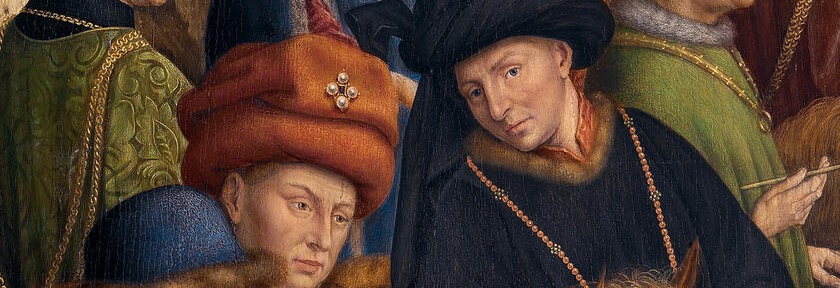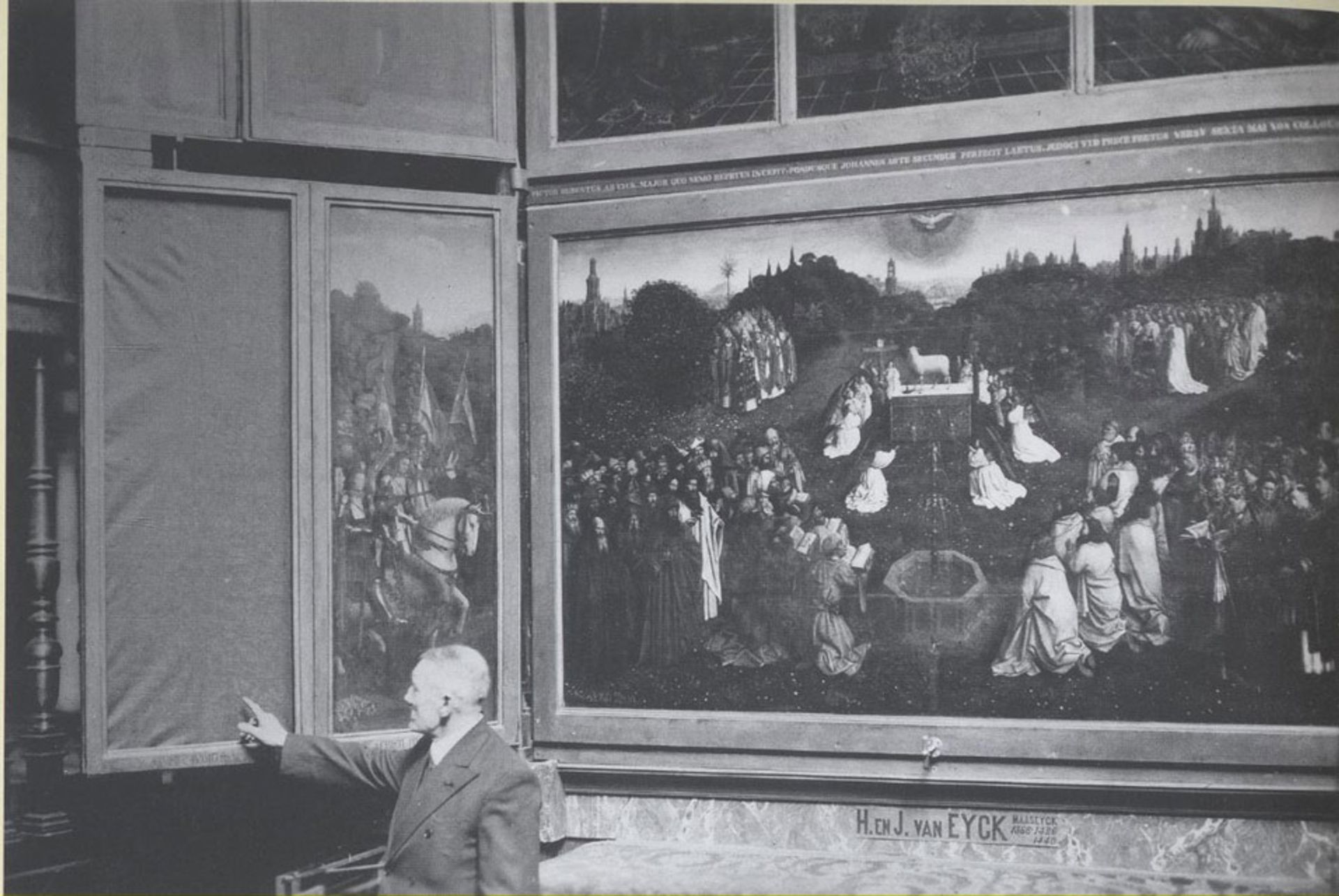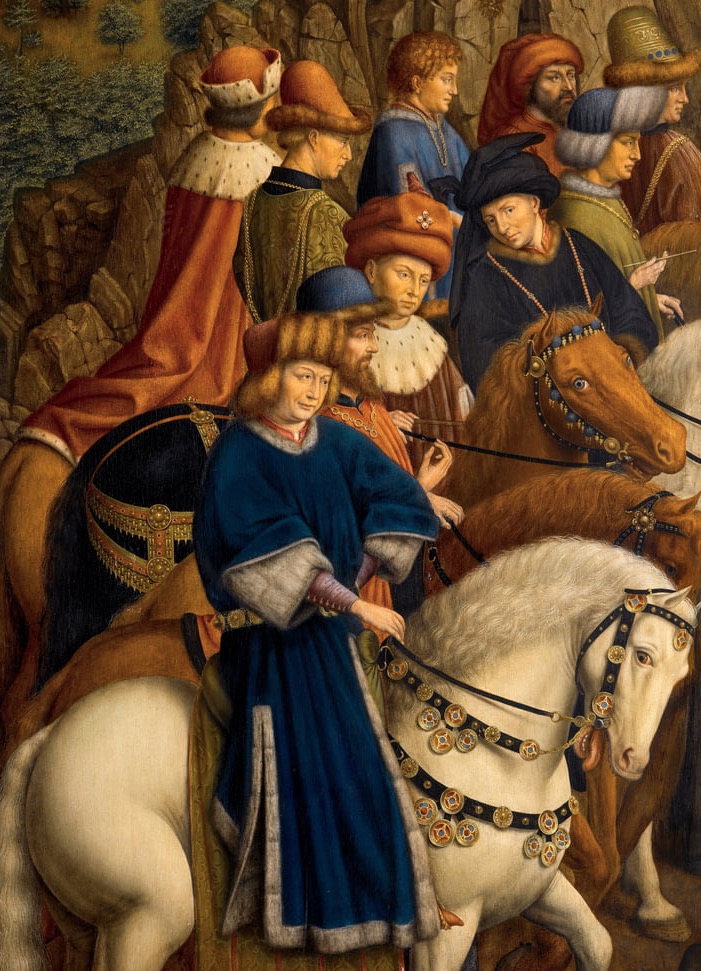
The Polyptych of the Mystical Lamb, a masterpiece of the Van Eyck brothers completed in 1432, is known not only for its extraordinary beauty and artistic complexity but also for having been the subject of numerous vicissitudes, including theft and looting. Particularly intriguing is the fate of the panel of the Righteous Judges, which disappeared in 1934 from St. Bavon Cathedral in Ghent, Belgium.
This theft is one of art’s greatest mysteries and has generated theories and initiated research that has lasted for decades.
Righteous Judges panel stolen in Ghent

Despite numerous investigations and the search that followed, the panel of the Righteous Judges stolen from the Mystic Lamb Polyptych in Ghent has never been recovered. However, the importance of the Polyptych and its fascination with the public have led to the creation of several copies of the missing panel over the years.
One of the best known is the one made by Jef Van der Veken in 1945, a restorer who reproduced the panel of the Righteous Judges based on photographs and detailed studies of the original work. This copy was inserted into the polyptych to fill the gap left by the original panel and still stands in the position that would have been occupied by the work executed by the Van Eyck brothers.
THEFT AND FATE OF THE STOLEN PANEL
What is certain is only the theft, which occurred in April 1934 and which the sacristan of St. Bavon Cathedral noticed. In place of the panel panel of the Righteous Judges and John the Baptist he found a note written in French that read:
Taken by Germany as a result of the Treaty of Versailles.
A few days later, on April 30, the bishop of Ghent received a ransom demand signed with the letters D.U.A. A negotiation was then initiated and the requested sum, one million Belgian francs, paid in order to get the panels back and prevent the threat of destroying them from becoming a reality.
In reality, however, only the John the Baptist panel was recovered and nothing more was heard of the Righteous Judges panel.
Hypotheses about the fate of the stolen panel are numerous.
Some theories suggest that the theft was commissioned by a private collector, who now owns the work in secret. Others believe that the panel may have been destroyed or lost during the wartime events of World War II.
Alleged finds of the panel have been reported over the years, but none have turned out to be authentic.
The anonymous letter detailing the hypothetical location of the panel, known as “The Letter 13,” has added to the mystery without leading to a concrete solution.
The mystery deepened, however, with the mysterious confession of businessman Arsène Goedertier, who had no apparent connection to the theft but confessed on his deathbed that he knew where the panel was located. Unfortunately, he was unable to state before his departure where it was located, but texts similar to the ransom demands sent were found in his home.
THE COPY OF THE PANEL OF JUSTICES INSTEAD OF THE ORIGINAL
Despite the absence of the original, the panel of the Justices continues to be a subject of great interest to scholars and the public alike, a symbol of the fragility of artistic heritage and, at the same time, of human passion for unsolved mysteries. The hope that one day it may be found and returned to its rightful place in the Polyptych keeps attention on this extraordinary work of art alive, testifying to the power of art to generate fascination and mystery across the centuries.
In place of the original Righteous Judges panel of the Polyptych of the Mystical Lamb, which disappeared in 1934, is a copy made by Belgian restorer Jef Van der Veken in 1945. This copy was commissioned to replace the missing panel and visually reintegrate the polyptych in its entirety, seeking to maintain the aesthetic integrity of the original work by the Van Eyck brothers.

Van der Veken relied on photographs and detailed studies of the work to create a reproduction as faithful as possible to the original panel, using the painting techniques of the time to emulate the style of Jan Van Eyck and his brother Hubert. This copy is included in the polyptych and is located in the Cathedral of St. Bavon in Ghent, Belgium, occupying the position that would have been of the original, thus allowing visitors to appreciate the polyptych in a form that is close to the original appearance conceived by its creators.

